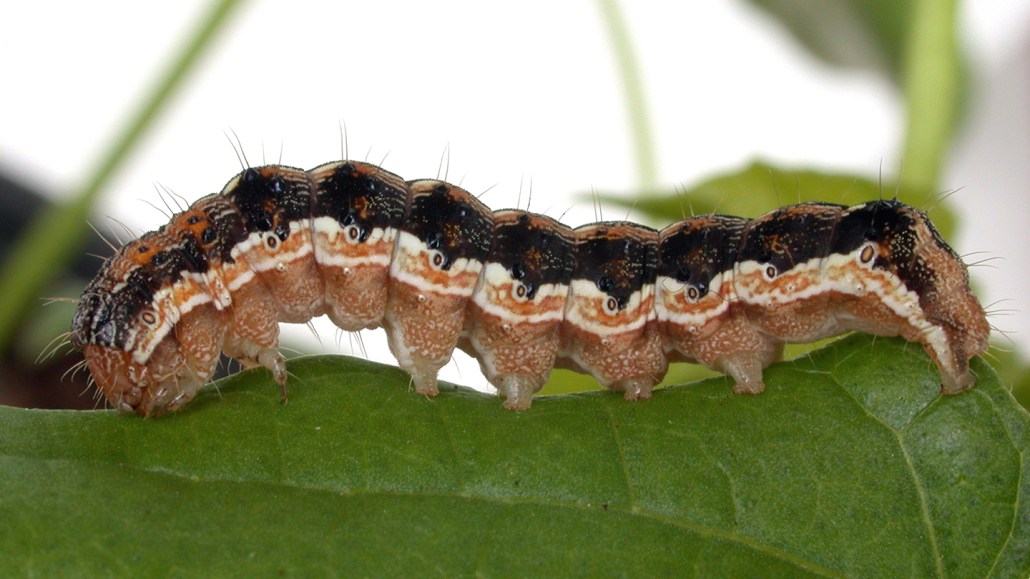
Caterpillars of the cotton bollworm moth (Helicoverpa armigera) shimmy skyward when infected with a gene-manipulating virus that ups the insects’ attraction to sunlight.
David McClenaghan/CSIRO (CC BY 3.0)
Higher and higher still, the cotton bollworm moth caterpillar climbs, its tiny body ceaselessly scaling leaf after leaf. Reaching the top of a plant, it will die, facilitating the spread of the virus that steered the insect there.
One virus behind this deadly ascent manipulates genes associated with caterpillars’ vision. As a result, the insects are more attracted to sunlight than usual, researchers report online March 8 in Molecular Ecology.
The virus involved in this caterpillar takeover is a type of baculovirus. These viruses may have been evolving with their insect hosts for 200 million to 300 million years, says Xiaoxia Liu, an entomologist at China Agricultural University in Beijing. Baculoviruses can infect more than 800 insect species, mostly the caterpillars of moths and butterflies. Once infected, the hosts exhibit “tree-top disease,” compelled to climb before dying and leaving their elevated, infected cadavers for scavengers to feast upon.
The clever trick of these viruses has been known for more than a century, Liu says. But how they turn caterpillars into zombies doomed to ascend to their own deaths wasn’t understood.
Previous research suggested that infected caterpillars exhibit greater “phototaxis,” meaning they are more attracted to light than uninfected insects. Liu and her team confirmed this effect in the laboratory using cotton bollworm moth caterpillars (Helicoverpa armigera) infected with a baculovirus called HearNPV.
The researchers compared infected and uninfected caterpillars’ positions in glass tubes surrounding a climbing mesh under an LED light. Uninfected caterpillars would wander up and down the mesh, but would return to the bottom before pupating. That behavior makes sense because in the wild, this species develops into adults underground. But infected hosts would end up dead at the top of the mesh. The higher the source of light, the higher infected hosts climbed.
The team moved to the horizontal plane to confirm that the hosts were responding to light rather than gravity, placing caterpillars in a hexagonal box with one of the side panels illuminated. By the second day after infection, host caterpillars crawled to the light about four times as often as the uninfected.
When the researchers surgically removed infected caterpillars’ eyes and put the insects in the box, the blinded insects were attracted to the light a quarter as often as unaltered infected hosts. That suggested that the virus was using a caterpillar’s vision against itself.
The team then compared how active certain genes were in various caterpillar body parts in infected and uninfected larvae. Detected mostly in the eyes, two genes for opsins, the light-sensitive proteins that are fundamental for vision, were more active after an infection with the virus, and so was another gene associated with vision called TRPL. It encodes for a channel in cell membranes involved in the conversion of light into electrical signals.
When the team used the gene-editing tool CRISPR/Cas9 to shut off the opsin genes and TRPL in infected caterpillars, the number of hosts attracted to the light in the box was cut roughly in half. Their height at death on the mesh was also reduced.
Baculoviruses appear capable of commandeering the genetic architecture of caterpillar vision, exploiting an ancient importance of light for insects, Liu says.
Light can cue crucial biological processes in insects, from directing their developmental timing, to setting their migration routes.
These viruses were already known to be master manipulators in other ways, tweaking their hosts’ sense of smell, molting patterns and the programmed death of cells, says Lorena Passarelli, a virologist at Kansas State University in Manhattan, who was not involved with the study. The new research shows that the viruses manipulate “yet another physiological host process: visual perception.”
There’s still a lot to learn about this visual hijacking, Passarelli says. It’s unknown, for instance, which of the virus’s genes are responsible for turning caterpillars into sunlight-chasing zombies in the first place.






